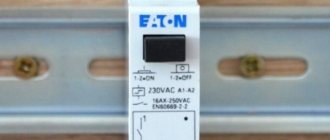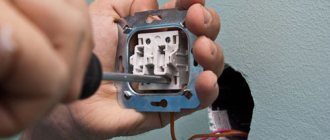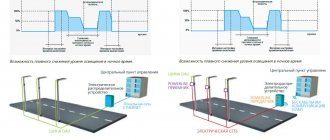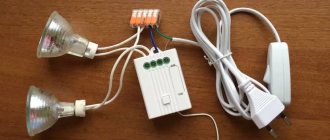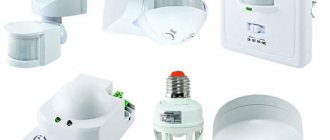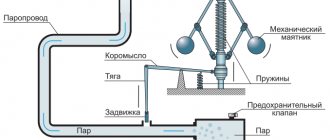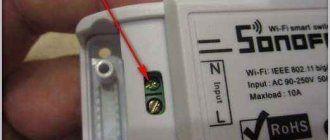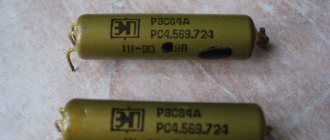When installing automatic lighting control systems, various types of switches can be used. Some devices, for example, marching and walk-through products, provide a fairly high level of comfort when controlling lamps, but the simplest and most convenient is a circuit with a pulse relay. Such a device can be in 2 different states, which can be controlled remotely. The pulse relay used to control lighting will be discussed in more detail below.
For what purpose are pulse circuit breakers used?
A feature of this type of relay is the ability to fix in any one position after applying an electrical signal to its contacts. Such bistability of an electronic element is convenient for controlling many devices and mechanisms, but in everyday life, it is most often used in circuits for switching on lighting devices. For example, lights in a long hallway can be switched off from different rooms, making it easy to “travel” through a house or apartment, always maintaining the required level of lighting where needed.
One of the advantages of a pulse device is the ability to “remember” the last position of the contacts, even in cases where there is a complete blackout of the electrical network, the last position of the contacts is retained.
The advantage of a pulse-type relay is also that low voltage can be used for its operation. Thanks to this electrical wiring, the switch can be located in a very humid area, such as a bathroom or basement. Thus, a significantly higher level of safety is achieved during the operation of electrical systems compared to conventional switches.
Relay operation in non-standard situations
Many people wonder what will happen to the relay when the voltage in the house disappears and then appears? In this case, will all the lamps light up at the same time? No, that won't happen.
However, the contact location status will vary depending on the specific model. With memory or not. If the memory is present, previously turned on lamps will turn on again. Where there is no memory, the contacts will simply open.
What happens if two people press two buttons at the same time? This will be interpreted as a single press. That is, the light will either turn on or off depending on its previous position.
The cabinet-mounted pulse relay has the form factor of a modular contactor and is mounted on a DIN rail. The rated current of most models is 10-16A.
This is quite enough for arranging lighting in an apartment or country house.
If you want to connect a more powerful load, you will have to use a starter in the circuit or choose models with higher currents.
Where can I buy
You can purchase the device either in a specialized store or online in an online store. In the second case, the budget option for purchasing products on the Aliexpress website deserves special attention. For some products there is an option for shipment from a warehouse in the Russian Federation; they can be received as quickly as possible; to do this, when ordering, select “Delivery from the Russian Federation”:
| Impulse relay TOMZN | Impulse relay CHNT | Pulse relay SOLARD EPN510 |
| Surge and overload protection relay EARU | Voltage regulator SINOTIMER | BIS-402 Pulse relay |
Second installation option
Can you connect the impulse relay yourself?
Yes, I can do it myself No, I don’t understand
When using this option for connecting relays to switches, fewer wires will be required, and their cross-section can be smaller - from 0.5 mm2. In this case, another protective device is needed. This connection option is used less often than the first. Detection of faults in the circuit is simplified here by the use of two machines designed for 6 and 10 amperes.
Design and principle of operation
The design of the pulse device is very simple, but this fact is not a disadvantage of the product; on the contrary, the presence of a small number of elements can significantly increase the reliability of the product. Such an electronic device consists of the following parts:
- Reels.
- Core.
- Movable anchor.
- Contacts
The relay coil consists of a large number of turns of copper wire. During manufacturing, the conductors are treated with a special varnish, which eliminates the possibility of a short circuit (under standard operating mode of the device). The core consists of a magnetic material and is a movable element that acts on the armature, which, in turn, sets the electrical contacts in motion.
Thanks to the design features of the contact opening system in the pulse device, it is possible to achieve reliable fixation of these elements in any one position.
Advantages and disadvantages
If we consider the pros and cons of pulse relays, this must be done for each type separately. Electromechanical switches have the following advantages:
- Favorable cost compared to electronic ones.
- Powerful 5 kV insulation between the contact group and the winding coil.
- Low voltage drop across the switched off contacts, which means a low percentage of device heating.
- Inert to surges and interference that occurs during lightning.
- Ability to control a line with an optimal load of up to 0.4 kV.
Among the disadvantages of electromechanical pulsed light switches, the following are noted:
- The occurrence of radio interference when the circuit is turned on and off. To avoid this effect, you need to resort to shielding, or increase the distance from the relay to devices exposed to external waves.
- Relatively rapid wear of the switch at high voltages and currents. This includes deformation of springs and oxidation of contacts.
- Longer response time than circuit breakers.
Electronic pass-through relays are characterized by the following advantages:
- excellent switching speed;
- good security for the master and users;
- wide selection of models;
- reasonable cost;
- the presence of indicators notifying about the operating mode of the device;
- silent operation;
- expanded range of possibilities.
Electronic relays can be mounted in different ways - on the DIN rails of the panel or directly in the socket box.
The disadvantages of the devices include:
- severe overheating to a critical point under the condition of high current switching;
- disruption of work at the slightest network failure;
- frequent “glitches” with impulses that are unreasonable in the master’s opinion;
- presence of high resistance in the closed position;
- turning off the relay if there is a short-term voltage drop in the network;
- the ability to operate some types of devices only with direct current;
- slow passage of current in the opposite direction to the usual direction due to the characteristics of the semiconductor circuit.
Despite the fact that electronic controlled switches have a large number of disadvantages, the devices are constantly being refined and improved. Therefore, it is possible that they will soon replace electromechanical relays completely.
Types of pulse relays
The most common electromechanical type of pulse device was described above, but modern devices of this type can be implemented on a control chip. This design consumes more power due to the constant standby state of the device, but produces less noise when the contacts operate.
Pulse devices equipped with a microcontroller have wider functionality. For example, in addition to the ability to fix the switch in a certain position, you can set the time to turn off the light (for devices equipped with a timer).
Electronic relays also have break contacts, but they are driven by an electronic circuit that controls the moment they are latched. Devices of this type can be installed in electrical systems with different supply voltages.
The main disadvantage of electronic relays is their low resistance to interference and voltage surges. In terms of cost, such products are also significantly inferior to electromechanical products (electronic IRs are more expensive).
What additional accessories do you need to purchase to connect a pulse relay?
To install the circuit you will need:
- push-button switches in a quantity corresponding to the number of control places;
- power wire or cable that can withstand the main load from the lamps;
- low-current wiring that provides parallel connection of all buttons with impulse relays
- a common electrician's tool.
Pushbutton switches
Any models that operate without fixing the pressed position with self-return due to the force of the built-in spring are suitable. It can be:
- custom-made unique products with an original design and one, two, three keys in a common body;
- redesigned light switches;
- door lock buttons, even equipped with a backlight indicator;
- other similar devices.
Such push-button products can be successfully integrated into the beautiful interior of an apartment.
The function of self-return of the button to the off position by the built-in spring is important: some manufacturers indicate in the descriptions that the time of applying voltage to the coil should not exceed one minute - otherwise its insulation may burn out.
Do not place these buttons where they could be accidentally pressed by a random foreign object (the back of a chair, a vase or a book on the table). Yes, and children need to be explained that they shouldn’t play with the light for a long time.
From the point of view of an electrician, for the reliability of the circuit, we are interested in the fact that when the button is pressed, its contact should close, and after releasing it, reliably return to the open position.
Power wire for lighting
Among the large assortment of modern wires and cables, in principle, you can choose any one that suits the price and operating conditions in household wiring.
To ensure safety and reliability of long-term operation, it is important to correctly calculate its load power characteristics. Our online calculator is designed to make this process easier.
Low current wiring
In principle, any wire or cable will do, but due to the short-term effect of a very small load, it makes sense to save on its cost and dimensions and use a regular copper telephone “noodle” or twisted pair with a certain number of cores.
You can also use any thin copper conductor. When choosing it, the main attention should be paid to only two questions:
- state of electrical insulation;
- mechanical strength of cores capable of withstanding loads during installation and operation.
Specifications
When installing lighting systems that will be switched on from a pulse device, it is necessary to take into account the basic parameters of such a product. If the device is not designed for the connection load or network voltage, it can instantly fail. In the documentation for the pulse device, the manufacturer indicates the most important characteristics. Among the main parameters that you need to know before deciding to use a particular IR model are:
- Output current - the maximum value of the current that appears in the coil when the armature moves (for electromechanical devices).
- Trip value - indicates the signal that causes the relay to operate automatically.
- Pull-in current is the minimum current value for the relay to operate.
- Return coefficient is the ratio of the armature output current to the retraction current.
When selecting and using a relay, you should also consider the voltage and current limits for which the relay is designed.
The device passport may also indicate the response time. There are fast-type products that turn on in 0.001–0.05 s and devices with a long delay (about 1 s).
Varieties
Today, such a device is presented on the market under different brands. The most popular are the following:
- ABB,
- Schneider Electric,
- Legrand,
- IEK,
- Finder and others.
They all work on the same principle of controlling a coil that is exposed to a short voltage pulse. The operating cycle includes a pulse effect during which the device is turned on and off. The principle of cyclic control is applied to all relay models.
It is used in different types of models:
- electromagnetic;
- induction;
- magnetoelectric;
- electrodynamic.
In automation systems, electromagnetic modifications are most often used due to their reliability, based on the principle of the action of electromagnetic force in the ferromagnetic core of such a device when current is supplied to the coil. The contacts are connected by a frame, which, at a certain position, attracts to the magnetic core, and in the second position is pulled back using a spring.
Connection diagrams
A pulse relay can be used to control lights. To ensure the operability of electrical systems with installed switching elements of this type, it is necessary to correctly perform the work of connecting the conductors.
First of all, it should be borne in mind that a pulse-type relay is not equipped with any protection elements, therefore, if a short circuit occurs in the electrical wiring of lighting devices, not only the relay contacts may burn out, but also the ignition of any flammable objects located in the immediate vicinity of copper conductor. To minimize possible consequences, the installation of pulse relays should be carried out only after the machine (or fuses (plugs)).
Push-button switches are used to switch relay modes. Such elements of electrical fittings are equipped with spring elements that return the button to its original position immediately after the mechanical pressure on its surface ceases. This is a very important point, because if the contact is closed for too long, the coil winding may overheat and the product (electromechanical) will fail.
Many manufacturers of impulse switches indicate in the product documentation that it is impossible to supply electric current to the coil for a long time (usually no more than 1 s).
The number of switches with which a signal is supplied to the pulse relay is not limited in any way, but, in many cases, there are 3-4 buttons in the device connection diagram. This is enough to control the light from several places.
All push-button switches are connected in parallel to each other. This feature of controlling a pulse device allows you to use a significantly smaller number of wires, compared to other methods of installing a control system for one light device from different places. One wire of the contact system of switches is connected to the electrical wiring phase, the other is connected to the pulse relay (contact A1).
In addition to supplying the phase wire from the switches, the phase is connected to contact “2” of the pulse device. This ensures the transmission of a signal to turn it on (off), as well as providing the device with electric current to supply voltage to consumers (lighting devices).
“Zero” is connected to contact “2”. Lighting devices are connected to the “ground” not through a switching device. The neutral wire is connected to the lighting fixture from the neutral bus.
Physical placement of the pulse relay is possible both in electrical panels and in the immediate vicinity of the lighting device (installation is carried out in a junction box).
It is also important to know 3 features of connecting R.
The most common example is the use of a relay to which multiple pushbutton spring return switches are connected. They are connected in parallel to each other in compliance with the basic requirements.
To organize a lighting control circuit, you need to connect the power wire to a bistable relay. The switches themselves are connected together using two-wire wiring. As a result of this, in the future it becomes possible to de-energize the entire network and use only one switch for this.
This option is popular because it allows you to simplify installation, but fully achieve your goal. Allowable specifications, such as support for LED button illumination, must be accurately calculated, otherwise the network will not function properly.
For convenience, you should check the labeling. Manufacturers use the following designations:
- A1-A2 - coil contacts.
- 1-2 (or other numbers) - designation of the number of contacts that close and open when the pulse relay operates.
- ON/OFF - designation of contacts that switch the relay to the off or on state (suitable for installing central control).
Most often, 220V relays are used, because the connection is made to the power panel. To do this, you need to connect the cables to the appropriate contacts, so that further control is carried out through a pulse relay. Individual switches in the lighting system are connected by wires.
The signal current for relay operation is always less than the main circuit current. When installing an electrical network and creating a lighting system, small cross-section wires are used to connect between relays and switches. This option is not recommended without installing an RCD (residual current device) in the electrical panel. The entire system is assembled at separate levels - from the electrical panel to the lamps.
Pulse relay. Controlling lighting in a house and apartment.
Pros of the device
The use of a pulse relay for organizing control of electric lighting has a large number of advantages. The main positive properties of such systems are:
- Relatively low price.
- Long service life.
- You can use an unlimited number of switches (buttons).
- Relatively low power consumption.
- Easier installation compared to main switches.
When using electronic devices, you can set the time after which the power will turn off.
Application area
In smart home control circuits, pulse relays are the main actuator. Some models are equipped with an additional input, in addition to the main one, for group shutdown. An example of centralized control of the RIO-1 relay:
Smart home control circuit
For example, you have two floors, and when you left, you forgot to turn off the lights on the second floor. In order not to return to the switch, all electronic light switches are integrated into a group control network, when a signal is sent to which they go to the off position. That is, you can turn off the lights from one place, and then turn on each one individually with a button.
Cons of a pulse relay
Pulse-type relays are not without their drawbacks. The most noticeable disadvantages of using such systems are:
- Generation of electrical noise.
- Quite a loud click when the contacts are turned on.
- Rapid wear of moving parts is possible (with very intensive use).
You can almost completely get rid of the listed disadvantages by installing electronic relays, but such devices will cost much more than electromechanical ones (2-3 times).
Connection options
There are several options for installing such devices, which have their pros and cons. For most modifications of such a device, the contact designation is as follows:
- N - neutral wire;
- Y1 - enable input;
- Y2 - shutdown input;
- Y—on/off input;
- 11-14 - switching contacts of the normally open type.
Before starting installation, you must carefully study the device passport, where other decryptions may be indicated.
Tips and tricks
Before purchasing and installing a pulse relay, it would be useful to familiarize yourself with the most common errors that may arise at this stage. Experienced professionals who install switching systems of this type often advise adhering to the following recommendations:
- If you purchase an electronic pulse-type relay, it is better to give preference to models equipped with a timer. With this feature, you can set the power to automatically turn off after a certain period of time. This function will be very useful for organizing lighting on the street, as well as in rooms that are visited frequently, but not for long.
- If you plan to install backlit switches (buttons), you should check with the seller in advance whether the relay can work with such elements of electrical fittings. Many IRs are very sensitive to the appearance of even a small current in the electrical circuit, and the presence of a resistive element will lead to activation of the system. In addition, the device may deteriorate, because the coil will be constantly energized.
- During installation work, all parts through which electric current flows must be well insulated. For this purpose, you can use special heat-shrinkable tubes, as well as PVC insulating tape.
- If there is a small child in the house, then it is better to install the buttons to activate the relay higher. Such products are well insulated and practically safe during operation, but children often start playing with the buttons by holding them on for a long time. Such actions often lead to failure of electromechanical type pulse relays.
- Most models of pulse relays with a coil are designed for 220 V. Such products are very easy to connect to the electrical network, but if you need to ensure a high level of safety in wet rooms, you should choose 12 or 24 Volt models.
- If you need to install several pulse relays that will be used to turn off various lighting devices, then you should choose models with central control. Such a device can be forcibly turned off by applying electric current to one of its contacts. Therefore, if you connect several of these elements to one switch, you can turn off all the lights in the house with one press of a button.
- If there is no desire or opportunity to purchase new buttons to turn on the light using a pulse relay, then you can remake ordinary switches. For this purpose, it is necessary to install small springs under the keys so that after stopping pressing they return to their original position.
- When installing a large number of impulse switches, to save space, the buttons can be placed in one socket box.
A pulse relay is a very interesting product in its design and functionality, which can and should be used to organize more comfortable control of lighting devices. If a high-quality device is selected and the installation of the product is carried out without errors, then such a system will last for many years.
Why only push-button ones?
When using impulse relays, other types of switches are already used - push-button, bell or push-button.
Note that simple one- or two-key keys will not work here.
With rare exceptions, for example, for the RIO-2 meander relay. But we'll talk about this later.
Based on this, you cannot apply a signal to the pulse relays for too long, otherwise the coil will burn out. Some manufacturers warn that the continuous signal time on their models should not exceed 1 minute.
And some children really like to play with these buttons, after which they fail.
Push-button switches look like regular ones, only inside their design there is a return spring, which after each press returns the key and contact to their original position.
The case also has two-button buttons.
They come in handy when you want to connect general lighting in the kitchen to a relay and at the same time lighting the worktop area.
Or in the hall: a chandelier and perimeter lighting, as well as a separate wall lamp.
Many people use spring-loaded doorbell buttons instead of dedicated switches.
Circuit without wires
What to do if your home has already been renovated and there is no separate switch near the door? You won’t re-drill the walls and tear off the wallpaper to run wires there.
Is it possible to connect a master switch in this case? Yes, you can. To do this you will need a radio controlled remote switch.
These are sold in many Chinese stores on Ali. They are even used as checkpoints.
Just glue it to any surface (even glass), and in the shield in front of the contactor install a power radio module the size of a matchbox.
Error No. 10 But again, do not connect the entire load through this module directly.
It's not designed for that. It must be placed in front of the contactor coil, and not instead of it!
To one such module you can even attach not one, but several switches or even a key fob for remote control from the car. More details
The wiring diagram for the wireless remote master button is shown below:
https://youtube.com/watch?v=_jXiCUgEMb0%3F
Operating principle and appearance
Generally speaking, a relay is an electrical mechanism that makes or breaks an electrical circuit. Its operation is carried out based on electrical or other parameters that act on it.
When choosing the operating mode of the relay, you need to be guided by the frequency of switching on, the magnitude of the current, as well as the nature of the loads being tested.
The structure consists of the following components:
- Coils: A coil is a copper wire that is wound on a non-magnetic material; may be in fabric insulation or coated with a special varnish that does not allow electricity to pass through;
- Core. It contains iron and is activated when current passes through the turns of the coil;
- Movable armature. Such an armature is a plate attached to the armature; it acts on the closing contacts;
- Contact system. It is a circuit state switch.
The operation of a relay is based on the electromagnetic force that appears in the coil core when current is passed through it.
The coil is a retracting device in which the core is connected to a movable armature. It activates the power contacts. And you can additionally connect a resistor to the coil to increase the operating accuracy.
